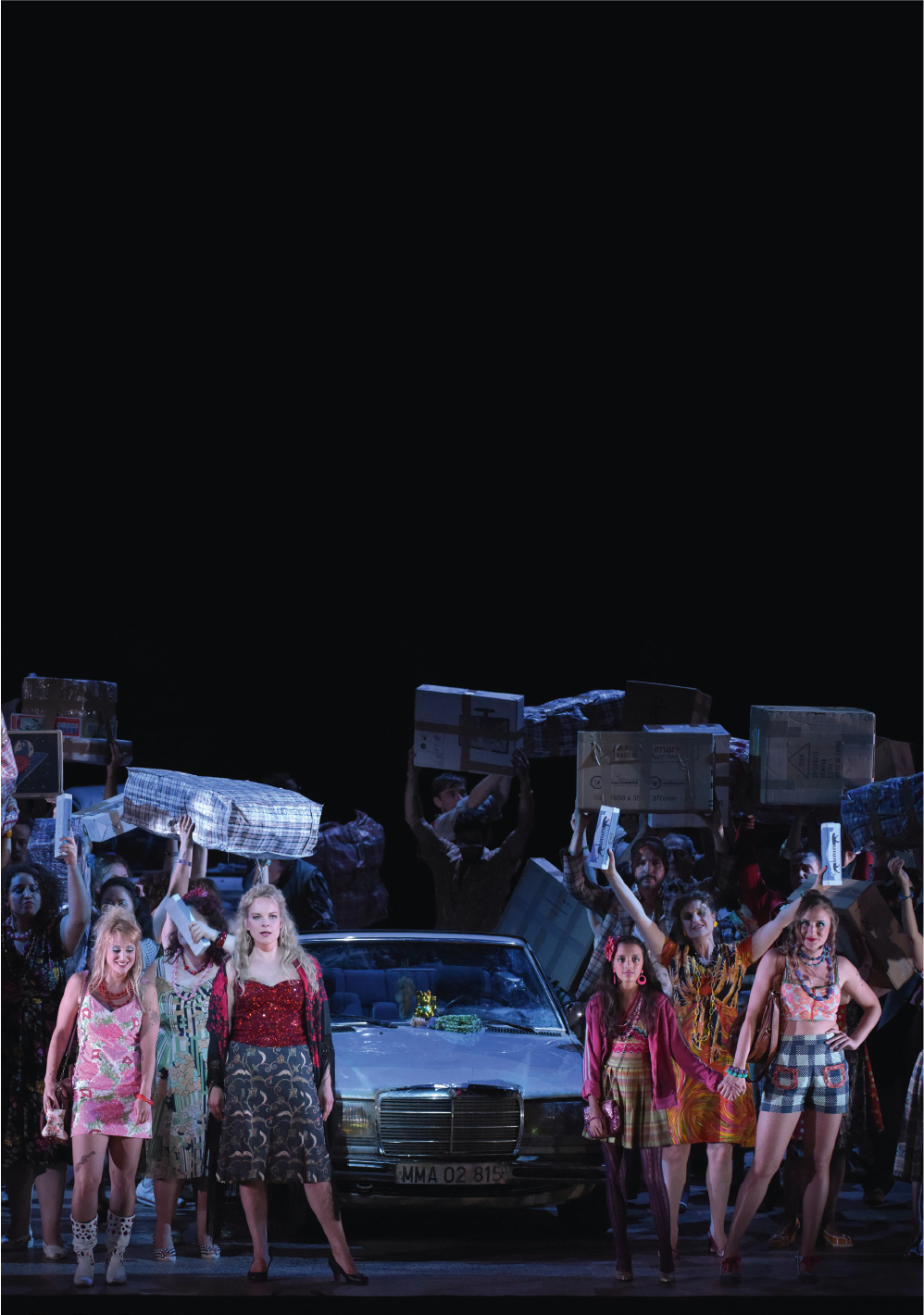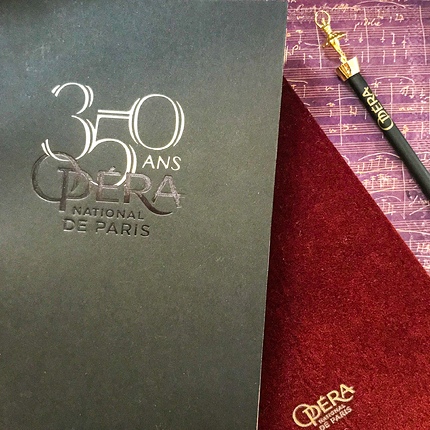Synopsis
Over and above the six pieces he composed for the ballet, Ravel’s entire body of work is an inexhaustible source of choreographic inspiration, no doubt thanks to the spatial potential inherent in his genius for orchestration. Written in the aftermath of the First World War, La Valse is meant to represent the “fantastic, inevitable, swirling” demise of the Viennese waltz and the world it represented. In keeping with that idea, George Balanchine’s 1951 choreography blends apparent joy with a touch of romantic torment. In 1975, in a very different spirit, Jerome Robbins adapted the Piano Concerto in G, composed by Ravel on his return from a tour of the United States during which he had discovered jazz. Framed by two movements reminiscent of musical comedy, a duo of incredible grace exalts the classical vocabulary. Finally, Sidi Larbi Cherkaoui and Damien Jalet conclude the programme with a fascinating Boléro which takes us through a maelstrom of movements electrified by the scenography of artist Marina Abramović and costumes by Riccardo Tisci.
Duration : 1h50 with 2 intervals
Artists
Creative team
Cast
- Tuesday 02 May 2017 at 19:30
- Wednesday 03 May 2017 at 19:30
- Saturday 06 May 2017 at 19:30
- Wednesday 10 May 2017 at 19:30
- Thursday 11 May 2017 at 19:30
- Sunday 14 May 2017 at 14:30
- Tuesday 16 May 2017 at 20:30
- Wednesday 17 May 2017 at 19:30
- Thursday 18 May 2017 at 19:30
- Saturday 20 May 2017 at 14:30
- Saturday 20 May 2017 at 20:00
- Tuesday 23 May 2017 at 19:30
- Wednesday 24 May 2017 at 19:30
- Thursday 25 May 2017 at 19:30
- Friday 26 May 2017 at 19:30
- Saturday 27 May 2017 at 19:30
Latest update 24 May 2017, cast is likely to change.
Latest update 24 May 2017, cast is likely to change.
Latest update 24 May 2017, cast is likely to change.
Latest update 24 May 2017, cast is likely to change.
Latest update 24 May 2017, cast is likely to change.
Latest update 24 May 2017, cast is likely to change.
Latest update 24 May 2017, cast is likely to change.
Latest update 24 May 2017, cast is likely to change.
Latest update 24 May 2017, cast is likely to change.
Latest update 24 May 2017, cast is likely to change.
Latest update 24 May 2017, cast is likely to change.
Latest update 24 May 2017, cast is likely to change.
Latest update 24 May 2017, cast is likely to change.
Latest update 24 May 2017, cast is likely to change.
Latest update 24 May 2017, cast is likely to change.
Latest update 24 May 2017, cast is likely to change.
Latest update 24 May 2017, cast is likely to change.
Creative team
Cast
- Tuesday 02 May 2017 at 19:30
- Wednesday 03 May 2017 at 19:30
- Saturday 06 May 2017 at 19:30
- Wednesday 10 May 2017 at 19:30
- Thursday 11 May 2017 at 19:30
- Sunday 14 May 2017 at 14:30
- Tuesday 16 May 2017 at 20:30
- Wednesday 17 May 2017 at 19:30
- Thursday 18 May 2017 at 19:30
- Saturday 20 May 2017 at 14:30
- Saturday 20 May 2017 at 20:00
- Tuesday 23 May 2017 at 19:30
- Wednesday 24 May 2017 at 19:30
- Thursday 25 May 2017 at 19:30
- Friday 26 May 2017 at 19:30
- Saturday 27 May 2017 at 19:30
Latest update 24 May 2017, cast is likely to change.
Latest update 24 May 2017, cast is likely to change.
Latest update 24 May 2017, cast is likely to change.
Latest update 24 May 2017, cast is likely to change.
Latest update 24 May 2017, cast is likely to change.
Latest update 24 May 2017, cast is likely to change.
Latest update 24 May 2017, cast is likely to change.
Latest update 24 May 2017, cast is likely to change.
Latest update 24 May 2017, cast is likely to change.
Latest update 24 May 2017, cast is likely to change.
Latest update 24 May 2017, cast is likely to change.
Latest update 24 May 2017, cast is likely to change.
Latest update 24 May 2017, cast is likely to change.
Latest update 24 May 2017, cast is likely to change.
Latest update 24 May 2017, cast is likely to change.
Latest update 24 May 2017, cast is likely to change.
Latest update 24 May 2017, cast is likely to change.
Creative team
Cast
- Tuesday 02 May 2017 at 19:30
- Wednesday 03 May 2017 at 19:30
- Saturday 06 May 2017 at 19:30
- Wednesday 10 May 2017 at 19:30
- Thursday 11 May 2017 at 19:30
- Sunday 14 May 2017 at 14:30
- Tuesday 16 May 2017 at 20:30
- Wednesday 17 May 2017 at 19:30
- Thursday 18 May 2017 at 19:30
- Saturday 20 May 2017 at 14:30
- Saturday 20 May 2017 at 20:00
- Tuesday 23 May 2017 at 19:30
- Wednesday 24 May 2017 at 19:30
- Thursday 25 May 2017 at 19:30
- Friday 26 May 2017 at 19:30
- Saturday 27 May 2017 at 19:30
Latest update 24 May 2017, cast is likely to change.
Latest update 24 May 2017, cast is likely to change.
Latest update 24 May 2017, cast is likely to change.
Latest update 24 May 2017, cast is likely to change.
Latest update 24 May 2017, cast is likely to change.
Latest update 24 May 2017, cast is likely to change.
Latest update 24 May 2017, cast is likely to change.
Latest update 24 May 2017, cast is likely to change.
Latest update 24 May 2017, cast is likely to change.
Latest update 24 May 2017, cast is likely to change.
Latest update 24 May 2017, cast is likely to change.
Latest update 24 May 2017, cast is likely to change.
Latest update 24 May 2017, cast is likely to change.
Latest update 24 May 2017, cast is likely to change.
Latest update 24 May 2017, cast is likely to change.
Latest update 24 May 2017, cast is likely to change.
Latest update 24 May 2017, cast is likely to change.
Les Étoiles, les Premiers Danseurs et le Corps de Ballet
Orchestre de l’Opéra national de Paris
Media
Access and services
Palais Garnier
Place de l'Opéra
75009 Paris
Public transport
Underground Opéra (lignes 3, 7 et 8), Chaussée d’Antin (lignes 7 et 9), Madeleine (lignes 8 et 14), Auber (RER A)
Bus 20, 21, 27, 29, 32, 45, 52, 66, 68, 95, N15, N16
Calculate my routeAt the Palais Garnier, buy €10 tickets for seats in the 6th category (very limited visibility, two tickets maximum per person) on the day of the performance at the Box offices.
In both our venues, discounted tickets are sold at the box offices from 30 minutes before the show:
- €25 tickets for under-28s, unemployed people (with documentary proof less than 3 months old) and senior citizens over 65 with non-taxable income (proof of tax exemption for the current year required)
- €40 tickets for senior citizens over 65
Get samples of the operas and ballets at the Paris Opera gift shops: programmes, books, recordings, and also stationery, jewellery, shirts, homeware and honey from Paris Opera.
Palais Garnier
- Every day from 10:30 a.m. to 6 p.m. and until performances end
- Get in from Place de l’Opéra or from within the theatre’s public areas
- For more information: +33 1 53 43 03 97
Online
Palais Garnier
Place de l'Opéra
75009 Paris
Public transport
Underground Opéra (lignes 3, 7 et 8), Chaussée d’Antin (lignes 7 et 9), Madeleine (lignes 8 et 14), Auber (RER A)
Bus 20, 21, 27, 29, 32, 45, 52, 66, 68, 95, N15, N16
Calculate my routeAt the Palais Garnier, buy €10 tickets for seats in the 6th category (very limited visibility, two tickets maximum per person) on the day of the performance at the Box offices.
In both our venues, discounted tickets are sold at the box offices from 30 minutes before the show:
- €25 tickets for under-28s, unemployed people (with documentary proof less than 3 months old) and senior citizens over 65 with non-taxable income (proof of tax exemption for the current year required)
- €40 tickets for senior citizens over 65
Get samples of the operas and ballets at the Paris Opera gift shops: programmes, books, recordings, and also stationery, jewellery, shirts, homeware and honey from Paris Opera.
Palais Garnier
- Every day from 10:30 a.m. to 6 p.m. and until performances end
- Get in from Place de l’Opéra or from within the theatre’s public areas
- For more information: +33 1 53 43 03 97
Online
Partners
-
Sponsor of Robbins/Balanchine / Cherkaoui, Jalet
-
With the support of AROP































































































